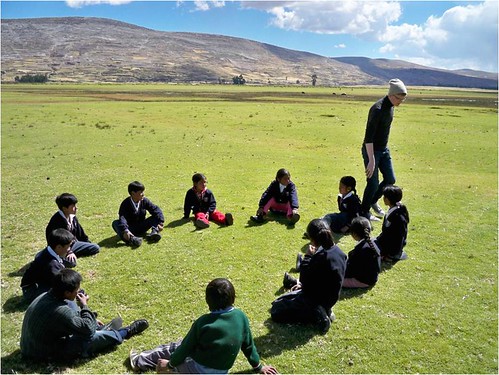
Photo: One Laptop per Child
Arguably so can a text book, the difference is the tactile nature of outdoors learning combing the feel, touch, smell and relative size of the subject and its association with its surroundings. Peter Carne, a former geography teacher with a passion for hands-on practical experience and a champion of “learning outside the classroom” says “Education in more than the acquisition of knowledge. Learning outside is a vehicle to develop the capacity to learn”.
There are some limitations. Planning a trip for 30 excitable children takes some organization which can sometimes limit the effectiveness. This is where parents can give great support or even take the lead role. Letting 30 children en masse see the inside of a synagogue, mosque or chapel needs tenacity and diplomacy. A parent and child combination introduces greater flexibility. The educational bond developed can turn the process of exploration into an educational game that supports progress back in class.
History, science, biology and geography are obvious choices for practical learning through parks, museums and theme parks. But maths? I recall a class trip to Wandsworth library in London when I was 9. Learning about the reference system and book indexing before ISBN coding still holds memories. But the highlight of the trip was on the way back. A quick detour to the engineering company next to the school had us enthralled. Our teacher commenced to yank out strands of our hair to play a maths game. The slight tear reaction – a little biology, psychology and more than likely now socially illegal the process produced the samples he was after. Using a micrometer the engineering manager measured the thickness of each strand in thousands of an inch – pre metric days. We queued delightedly to suffer the anguish of the hair tug and record the result. Back in class, the realisation that black hair was on average thicker than blonde. An educational game with a lasting memory, it happened 50 years ago.
Turning a trip out with mum and dad into an educational game is both great fun and mutually rewarding. The practical investigation and the relative knowledge gained help significantly back in class. The fact that the experience was gained outside the classroom provides a strong memory tag association when it comes to exams. What better way to appreciate the scope to the planetary system than look at the physical size of the Jodrell Bank telescope needed to study its detail? Marvel at engineering feats such the Thames barrier and question what could happen if it wasn't there, or see history in operation at the Beamish working museum. Whilst teachers need further encouragement, and time, to take the lead role wherever they can, the time spent in school only amounts to 195 days per year. The remaining 170 days, or using a little maths game; 47 percent of the total year are weekends and school holidays. Parents take note.
About the Author
The learning time in a classroom is limited. Operational constraints can reduce the core teaching time to around 30 per cent of the lesson length, but outside the class children see the practical reference point to their learning



0 comments:
Post a Comment